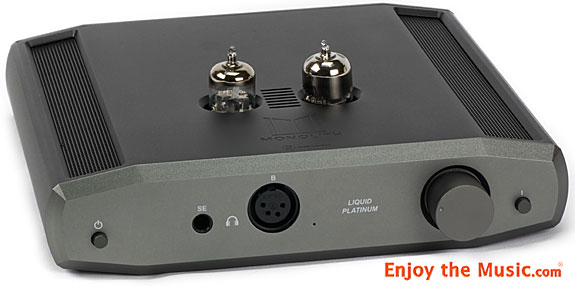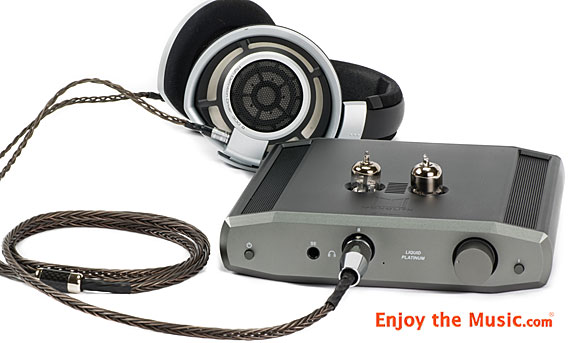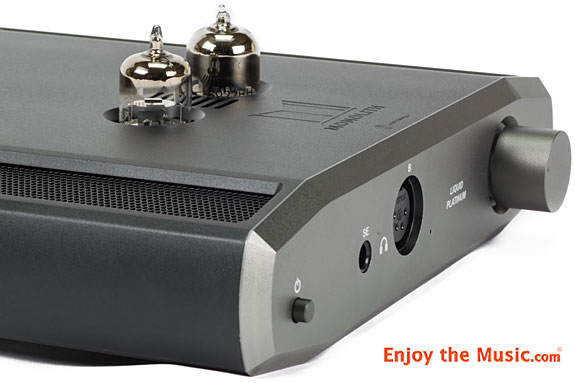
Monoprice Monolith Liquid Platinum Headphone Amplifier Review The Legend Returns: Monoprice resurrects a Cavalli Design that captures the imagination. Review By Dave Hanson

The Liquid Crimson was one of Cavalli Audio’s most legendary designs. Evolving from a tube hybrid circuit that first spawned the DIY EHHA, then later the Liquid Fire and finally the solid state Liquid Carbon, the $2850 Crimson was an audio show darling. The details absolutely floored people. The bass impact was massive. The mids were full and glorious. The treble was sweet and intoxicating. The stage was wide open. It was a piece people loved to talk about because it didn’t just do everything well, it did it in a way that was special.
But there was another design in this prestigious lineage that few knew about. On his way to developing the single-ended Liquid Crimson Dr. Alex Cavalli designed a fully-balanced version of the amplifier. It was eventually scrapped in favor of going all-in on the balanced solid state flagship Liquid Gold, but the design wasn’t forgotten.
Dr. Cavalli continued to tinker with the amplifier, and decided to resurrect it a couple of years ago at CanJam SoCal 2017. Debuting on a small circuit board, sans chassis, the Liquid Platinum prototype sounded nearly identical to the Liquid Crimson, which I was using as my main reference amplifier at home around that time. However, the Platinum was much smaller, offered a balanced design and was aimed at a price point that was roughly half the cost of the Liquid Crimson. Given the Crimson’s rarity and legendary status, I was thinking this was a definite home run.
Of course, as fate would have it, Dr. Cavalli decided to close the doors on Cavalli Audio a few months later, and the Liquid Platinum went back on the shelf. To me, this bordered on tragic, as it was a great design that would make the Crimson’s glorious sound financially accessible to many people for the first time.
Fortunately, Dr. Cavalli and several others felt the same way. And after some discussion, Monoprice decided to bring the design to light as part of their Monolith series of high-end audio products. What’s more, Monoprice was aiming to launch the Monolith Liquid Platinum at the very accessible price of $699, making it an even more affordable get for audiophiles.
I was overjoyed to hear this, as were several others, and a solid buzz began to grow on the forums. Would the Monolith Liquid Platinum be able to live up to the hype? Let’s find out!
What’s Within The Box? The Monoprice Monolith Liquid Platinum comes in a basic but handsome mix of gray and black. It measures about 8.75″ wide by 8.25″ deep and about 2″ high. The front panel includes a power button, 6.35mm SE and 4-pin balanced outputs, an analog volume pot, an input selector button, and a light to indicate power status.
The top of the unit has grates running along each side to vent heat, along with a smaller vent in the middle and two slots for 6922 / 6DJ8 / ECC88-type tubes.

The back panel has a jack for the power supply, one set of 3-pin balanced inputs, one set of RCA unbalanced inputs, and a “loop out” RCA output – which can send the unaffected signal from the SE input to another device (note: this is not a preamp out. There is no volume control.).
The amplifier features a phase splitter for the SE input, allowing for balanced output from either type of source signal. In balanced mode, it will output up to 3.6W per channel into 50 Ohms, which was, in my experience, enough to drive anything I threw at it. In SE mode, it offers about a quarter of that power with about 900mW into 50 Ohms. Both modes are very quiet, and it requires a pair of super sensitive IEMs like the Campfire Andromeda to hit the noise floor. This amplifier really isn’t made for IEMs anyway, as the volume will get dangerously loud very quickly and the channels may not be perfectly balanced in the first millimeter or two of the analog volume pot. I wouldn’t recommend using them without something like the iFi Audio iEMatch ($49) in the middle to give you some more range to play with the volume.
The Liquid Platinum runs pretty cool, being only slightly warm to the touch after several hours. Due to the Platinum’s smaller size, it is not able to run heavily in Class A mode like its hot-running predecessor, the Liquid Crimson, as it would melt the board and everything on it. On the plus side, this will be a lot nicer to run on a hot summer day.
Dr. Cavalli has also included a protection circuit on the Platinum just to help ensure against damage. I accidentally triggered it a couple of times trying to plug in headphones with the volume up and bassy music playing. Oops. Triggering the protection circuit will cause the light on the front to turn red and music will stop playing for about 30 seconds while the amp takes a little siesta.
While I wouldn’t go so far as to say, “It’s built like a tank”, it is a solid feeling component and nothing was loose, wonky or made me feel like it was destined to break. The Monolith Liquid Platinum has a good spread of features that make it useful in a lot of situations.
But enough of all this build quality stuff! Let’s move on to the fun part… the sound.
The Imaginarium Of Dr. Cavalli The Monolith Liquid Platinum, like the Liquid Crimson before it, is one of Cavalli’s most neutral sounding offerings. I wouldn’t call it an “analytical” sound, however. If anything, it is just a little midrange-centric, with the mids taking the front of the stage, the treble and midbass relaxed just a hair behind, and the sub-bass just a bit further back behind that. The resulting sound is very intimate – not intimate in the way of staging, but intimate in a way that puts you closer to the artist. The sound has a sort of warm, glowing vitality to it. A bit of romanticism that makes the music sound extra sweet, but not so much coloration that it would disturb the overall accuracy.
That intimacy is really a defining feature, as the Liquid Platinum is able to capture such a stunning level of subtlety, the sound becomes incredibly captivating. The subtle quiver of a singer’s voice you’ve never noticed before. The microscopic nuance of the way one note is plucked – like a snowflake that is completely unique. When you combine that with a nice black background and the lovely, natural tonality of the amplifier, you can’t help but be struck on an emotional level. In this way, the Monolith Liquid Platinum gives you more than a reproduction of the music, it gives you an experience. It’s like it gets you closer to the intent of the music. If I was going to boil it down to one word, that word would be “evocative”.

Listening to the Song “Already Dead” off Beck’s album Sea Change, there is a little acoustic guitar riff at 1:10. Comparing to the HeadAmp Gilmore Lite Mk2 ($499), I can hear a very accurate picture of the guitar playing the riff in the studio on the GLM2. With the Liquid Platinum, it’s like I get a completely different, and perhaps even more vivid image – I hear that guitar and it’s like I’m transported to a dusty old western town with a tumbleweed blowing across the street. It’s like it evokes something that is halfway between a thought and an emotion in me. It triggers the imagination. The amplifier just has that right combination of tone, midrange musicality and subtle nuance to make that experience exceptionally vivid.
Does that make it the world’s greatest amplifier? No. Let’s clear that up before things go off the rails here. It is a very, very good amplifier, for sure. But the point I’m trying to make here is that the Liquid Platinum is an amplifier that is a very emotional, evocative listen. There is something about the sound that is very… human. It can easily leave you daydreaming or sobbing at your keyboard, because it connects you to the music in some powerful and unexpected ways.
And for listeners who really want their music to take them on a journey, this is going to be a hell of a lot of fun.
The Sound Of Liquid Emotion Going through the individual frequency ranges, the bass response is good, though not quite as otherworldly in terms of impact and rumble as the original Liquid Crimson, which was certainly helped by its larger onboard power supply. I suspect changing out the switch mode power supply for a true, dedicated linear power supply would give it another level of heft here. Compared to the MassDrop Cavalli CTH ($249), the Liquid Platinum certainly has much stiffer midbass impact and sub-bass rumble, so those looking to step up and give more body to their music will be well pleased with the results.
The bass response changed a bit from headphone to headphone, as different drivers respond to different designs. In most cases (HD800, Auteur, HE500, AEON, SR225i and Cascade), midbass and sub-bass were about average in terms of visceral impact, with the last octave of sub-bass being just a little bit rolled off and the midbass being a notch or two above average in terms of power.

Some planar magnetic headphones responded especially well to the Liquid Platinum’s bass delivery. The notoriously difficult Abyss AB-1266 can be quite choosy with its amp partners, but the Liquid Platinum was able to really make the AB-1266’s legendary low end sing. Bass lines moved with titanic force – like the ocean shearing away rock from cliff sides with every note (I told you, this thing is evocative!).
Switching to a picky dynamic driver, I decided to try my modded Denon AH-D2000, which absolutely loves the Liquid Crimson. Though it’s an easy headphone to drive, I find the D2000’s bass performance has a strong correlation with the amplifier’s power supply. In this case, I fed it several EDM tracks, and while the bass was very good, it wasn’t as heart-stoppingly powerful as it was on the original Liquid Crimson. I’d be curious to see how much that changes with a good linear power supply. Overall, I’d rank the bass performance across all headphones as a very good four stars.
Moving on to the midrange, the distinction between the Platinum and the Crimson became much more hazy. If I could describe the Liquid Crimson’s midrange in one word, it would likely be “mystical”. There was a special magic to those mids – a smoky, sultry quality – and the Liquid Platinum does a fantastic job of replicating it. Guitars and vocals are absolutely gorgeous. Listening to the second verse of Fleetwood Mac’s classic, “Gold Dust Woman”, Lindsey Buckingham plays a series of subtle slide guitar licks in response to the vocal. I’ve never heard them sound as good as they sounded on the Liquid Crimson with that deep nuance and that special mystical smoke on them. The Liquid Platinum is able to replicate that perfectly.
Vocals are breathtakingly beautiful, with a sweet and sophisticated intimacy that makes you feel like the artist is singing directly to you. As I mentioned before, the Liquid Platinum does an incredible job of capturing tiny nuances of the performance that make it feel more human… more emotional… more captivating. It’s a very grown-up and mature sounding midrange that is pretty tough to find at this sub $1000 price point, for sure.
The high frequencies are good and resolving, but perhaps not quite as elite as the Liquid Crimson in terms of smoothness. That is probably an unfair bar for the Platinum to measure up to, as the Crimson had one of the smoothest high ends I’ve ever heard. The Platinum still fares better than average. It does a good job of keeping the picky Sennheiser HD800 in check, that’s for sure. Picking out high frequency micro details like the ambience of a recording space is quite easy, and probably helped in part by some additional depth from the tubes.
The treble is very clear for the price, but not entirely grain-free, if I’m holding it up against the very highest standards. I think this is another area where the Platinum would be helped out greatly by a dedicated linear power supply instead of the SMPS. I can’t help but feel this is an amp that still has a lot more to offer in terms of scalability, as every time I run into a minor quibble, it seems to trace back to the power. One can’t say for certain without testing, but for someone like me who tends to experiment a lot with such things, this seems like a fairly obvious place to start if I want to try and upgrade the sound of the basic unit.

Attack speed is about average, not quite delivering the brilliant transient snap of the Blue Note Award-winning HeadAmp Gilmore Lite Mk2. The focus of the Liquid Platinum seems more tuned to deliver richness rather than speed. The body and decay of the notes are both quite lovely, with a trail of sonic information lingering behind every note detailing everything from the dimensions of the recording space down to the singer’s choice of herbal tea and Chapstick.
The soundscape and imaging are excellent. The forwardness of the midrange does seem to make vocals a bit closer to you, relative to a flatter presentation like that of the HeadAmp Gilmore Lite Mk2. As a result, there is a certain intensity to the Monolith Liquid Platinum that I really like. It feels more personal. It pairs perfectly with that sultry midrange and intimate signature to deliver a really cohesive experience.
But as I said before, I don’t want the use of descriptors like “forward mids” and “intimate sound” to be confused with nice ways of saying “a small soundscape”. The stage is quite large and well spread out, with each performer having plenty of room to operate without risk of blending into the others.
The amplifier offers very good width and a tubey sense of depth, where sounds layer out from near to far in a well-defined way. I don’t think it is able to project quite the same sense of depth as a true tube amp would, but among solid states and hybrids, it’s excellent, with a lively three-dimensional feel.

The Cavalli Magic Kudos to Alex Cavalli and the folks over at Monoprice for bringing this wonderful sounding amp to life. I vividly remember hearing that prototype at CanJam and being so excited for it to come out. I’m glad such a good design gets to see the light of day.
For a lot of people this amp is going to be an “End Game” score. It’s a hell of a lot of amp for $699. The Monoprice Monolith Liquid Platinum does a lot of things well, sounds great as it is, and I see that there is potential for it to grow, if you want to roll tubes or switch out the power supply. I always like that because I love to tinker. Either way, you have an excellent foundational piece to build around at the center of your system.
Overall, the Monoprice Monolith Liquid Platinum is an extremely beautiful sounding and richly detailed amp. It is able to uncover a lot of layers to the music that other amplifiers in this price range can’t seem to reveal. To me, for $699, this is certainly one of the best options out there. In terms of emotional gravitas and truly experiencing the music, it is tough to beat at any price.
Additional Equipment Used in This Review Sennheiser HD800 Sennheiser HD600 MrSpeakers AEON Flow Open ZMF Auteur ZMF Atticus HiFiMAN HE500 Grado SR225i Campfire Andromeda Campfire Vega FiiO FH5 Westone W60 Wells Audio Milo Headphone Amplifier Glenn OTL Tube Amplifier Cavalli Liquid Carbon HeadAmp Gilmore Lite Mk2 JDS Labs Objective 2 Massdrop CTH Monoprice Monolith Liquid Platinum Schiit Audio Magni iFi iDSD Black Label Chord Hugo 2 Schiit Audio Yggdrasil DanaCable Lazuli Headphone Cables DanaCable Onyx Interconnects DanaCable Trustream USB Cable Wireworld Electra 7 Power Cables PS Audio Duet Power Conditioner Roon Amarra 4 Luxe Tidal Hi-Fi
| Tonality |
    
|
| Sub–bass (10Hz – 60Hz) |
   
|
| Mid–bass (80Hz – 200Hz) |
   
|
| Midrange (200Hz – 3,000Hz) |
    
|
| High Frequencies (3,000Hz On Up) |
   
|
| Attack |
   
|
| Decay |
    
|
| Inner Resolution |
    
|
| Soundscape Width Front |
   
|
| Soundscape Width Rear |
   
|
| Soundscape Depth Behind Speakers |
   
|
| Soundscape Extension Into Room |
    
|
| Imaging |
    
|
| Fit And Finish |
   
|
| Self Noise |
   
|
| Value For The Money |
    
|
Specifications Type: Vacuum tube stereo headphone amplifier Rated Output: 3.6W @ 50 Ohm balanced, 900mW @ 50 Ohm SE Output Impedance: <0.1 Ohm Frequency Response: 20Hz to 20kHz (+/-0.1dB) THD+N: 0.007% @ 1VRMS Dimensions: 8.75″ x 8.5″ x 2.0″ (WxDxH) Weight: 3.2 lbs. SMPS: 36V 1.5A Price: $699
Company Information
Monoprice, Inc. 11701 6th Street Rancho Cucamonga, CA 91730
Voice: (877) 271-2592 Website: www.Monoprice.com















Want to join discussion?
Feel free to contribute!